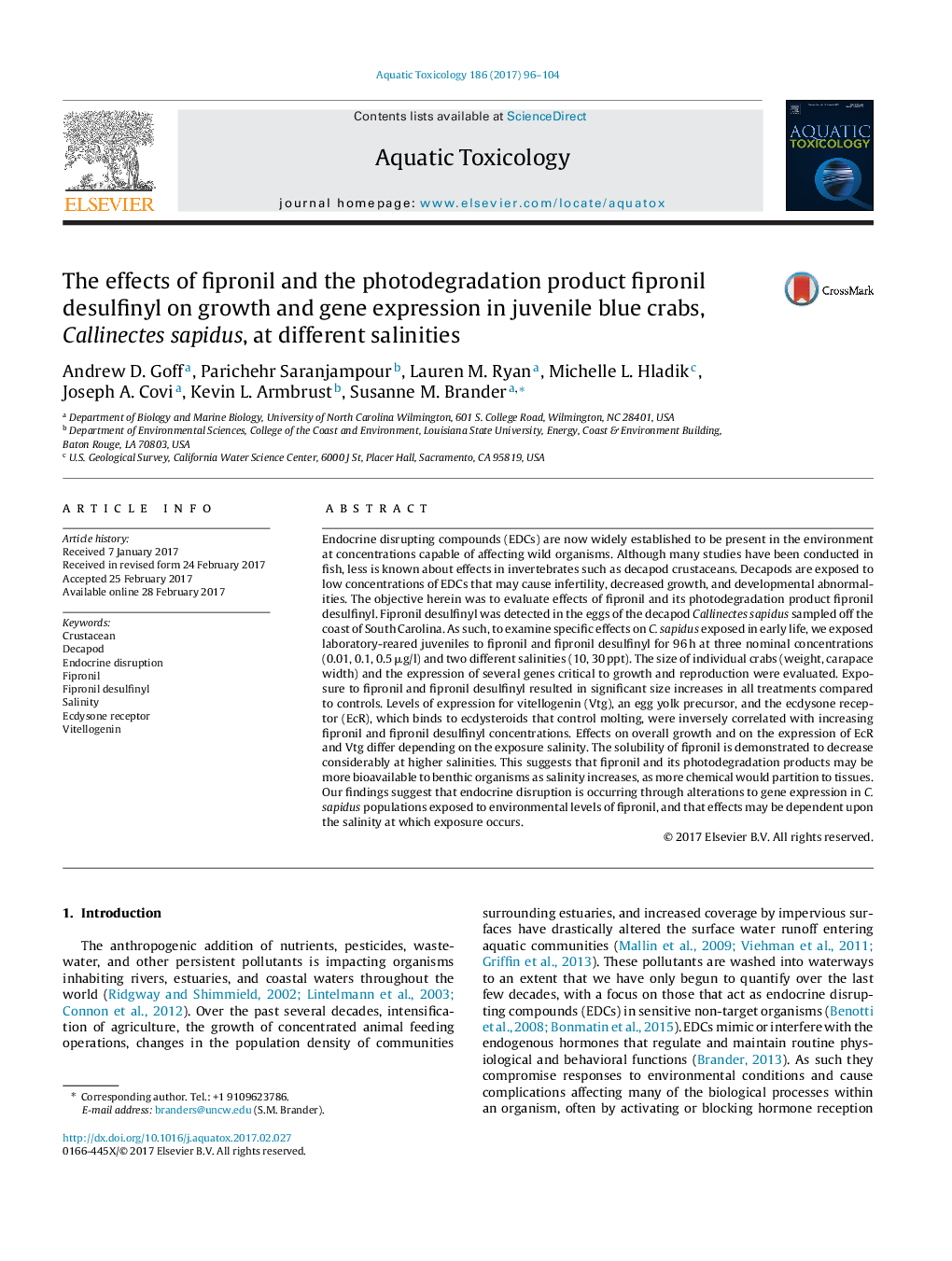| کد مقاله | کد نشریه | سال انتشار | مقاله انگلیسی | نسخه تمام متن |
|---|---|---|---|---|
| 5764318 | 1625919 | 2017 | 9 صفحه PDF | دانلود رایگان |
عنوان انگلیسی مقاله ISI
The effects of fipronil and the photodegradation product fipronil desulfinyl on growth and gene expression in juvenile blue crabs, Callinectes sapidus, at different salinities
دانلود مقاله + سفارش ترجمه
دانلود مقاله ISI انگلیسی
رایگان برای ایرانیان
کلمات کلیدی
موضوعات مرتبط
علوم زیستی و بیوفناوری
علوم کشاورزی و بیولوژیک
علوم آبزیان
پیش نمایش صفحه اول مقاله

چکیده انگلیسی
Endocrine disrupting compounds (EDCs) are now widely established to be present in the environment at concentrations capable of affecting wild organisms. Although many studies have been conducted in fish, less is known about effects in invertebrates such as decapod crustaceans. Decapods are exposed to low concentrations of EDCs that may cause infertility, decreased growth, and developmental abnormalities. The objective herein was to evaluate effects of fipronil and its photodegradation product fipronil desulfinyl. Fipronil desulfinyl was detected in the eggs of the decapod Callinectes sapidus sampled off the coast of South Carolina. As such, to examine specific effects on C. sapidus exposed in early life, we exposed laboratory-reared juveniles to fipronil and fipronil desulfinyl for 96 h at three nominal concentrations (0.01, 0.1, 0.5 μg/l) and two different salinities (10, 30 ppt). The size of individual crabs (weight, carapace width) and the expression of several genes critical to growth and reproduction were evaluated. Exposure to fipronil and fipronil desulfinyl resulted in significant size increases in all treatments compared to controls. Levels of expression for vitellogenin (Vtg), an egg yolk precursor, and the ecdysone receptor (EcR), which binds to ecdysteroids that control molting, were inversely correlated with increasing fipronil and fipronil desulfinyl concentrations. Effects on overall growth and on the expression of EcR and Vtg differ depending on the exposure salinity. The solubility of fipronil is demonstrated to decrease considerably at higher salinities. This suggests that fipronil and its photodegradation products may be more bioavailable to benthic organisms as salinity increases, as more chemical would partition to tissues. Our findings suggest that endocrine disruption is occurring through alterations to gene expression in C. sapidus populations exposed to environmental levels of fipronil, and that effects may be dependent upon the salinity at which exposure occurs.
ناشر
Database: Elsevier - ScienceDirect (ساینس دایرکت)
Journal: Aquatic Toxicology - Volume 186, May 2017, Pages 96-104
Journal: Aquatic Toxicology - Volume 186, May 2017, Pages 96-104
نویسندگان
Andrew D. Goff, Parichehr Saranjampour, Lauren M. Ryan, Michelle L. Hladik, Joseph A. Covi, Kevin L. Armbrust, Susanne M. Brander,